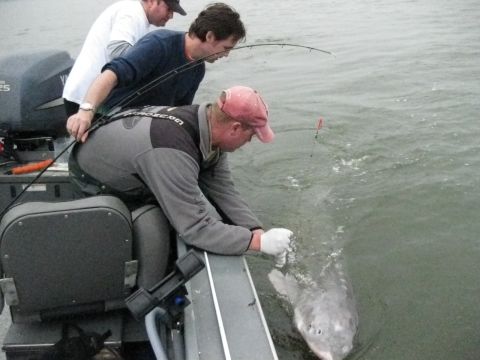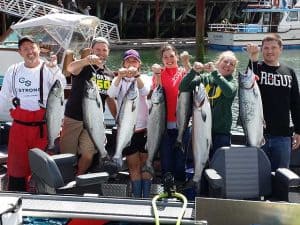Check out our Astoria Fishing Charters and Washington Halibut Charters
Sturgeon fishing tips and techniques are fundamental for consistently catching high numbers of sturgeon and big sturgeon.
The following 5 sturgeon fishing tips are techniques that I employ on a daily basis as a sturgeon fishing guide and they have put a lot of sturgeon in the boat over the years!
1. Fish where the sturgeon are.
Fishing where the sturgeon are may seem like an obvious statement, yet I can’t tell you how many times I see anglers fishing in areas that just don’t hold sturgeon or aren’t holding sturgeon at that particular time. Sturgeon are a very mobile fish, they move on the tides, they move to follow food, and they move to stay comfortable. These fish move a lot and they aren’t always moving where you expect them to be moving!
One of the best tools that an angler can have when pursuing sturgeon is a very good high end digital fish finder, such as the new Lowrance HDS series or a digital Humminbird or Furuno. It not only pays to have one of these units, but it pays even higher dividends if you really know how to use it. Read the manual, go out on the water and practice with it (not while fishing), and then read the manual again. These units are complex but they aren’t impossible to use, and a little bit of practice and reading goes a long ways!
Another tried and true approach to finding sturgeon, especially sturgeon that are willing to bite, is fishing in water that has adequate flow. As a general rule of thumb, big sturgeon are found in big fast-moving water. If you go to Bonneville your going to find that the big fish are in the fast water and the little fish are in the slower moving side areas and eddies. If your on the Willamette fish closer to the center of the river, the middle of the river has more flow. Big sturgeon like to eat big food and it takes a pretty good amount of current to move big food!
2. Keep your sturgeon bait fresh.
Keeping your sturgeon bait fresh … again pretty simple stuff, but it doesn’t matter if I’m salmon fishing, steelhead fishing, or sturgeon fishing, I see anglers trying to use their bait for way too long. I can understand the mindset that causes this behavior, it’s one of two things or a combination of both; “Well the fish aren’t biting right now, so my baits fine” or trying to conserve on bait because it’s expensive. The end result is the same,you’re not as likely to catch sturgeon on old milked out bait, as you are on fresh bait, or fresh out of the package bait.
Three things make sturgeon bait fish well; guts , blood, and slime coat. If the guts are missing from your sand shrimp or smelt/anchovy then the majority of its sturgeon attracting ability is gone. The same thing goes for the blood, a huge amount of the blood is in the guts and gills, when the blood is gone then the bait isn’t bait anymore it’s just a little fish on your hook.
The third thing really only applies to smelt and anchovies, and this is the slime coat. The slime coat is the outer protective coating that each fishes skin and scales are covered with. This slime coat is their first line of defense against infection from parasites and other nasty things that want to hurt them. When we smell a fish after touching or being close to it, it’s the slime coat that we smell, it’s this same slime coat that allows other fish to smell it when it’s used as bait. When the slime coat is gone, the bait doesn’t feel slimy anymore; it just feels like wet bait. Freezer burnt sturgeon bait and bait that has been soaked too long on the end of the line have both lost their slime coat, and should be changed out.
Don’t be this guy, “My bait looks just fine, I don’t need to change it.” I hear this all the time from my customers, many of whom have their own boat and are avid fishermen, and every time I smile and say “It’s not how it looks, it’s how it smells.” At least half of the sturgeon baits fish catching ability lies in the way it smells, and for you salmon fisherman out there, the herring’s flash and vibration attracts the fish but it is the smell of freshly baited herring that seals the deal.
Again don’t be that guy, change your bait often! Change your bait twice as often as you think you should, and if you want to catch even more fish then change your bait three times as often as you think you should! This is super effective and it’s not a secret, it’s just work, and yes, extra bait money.
3. Move around.
Sturgeon fishing on anchor is not the same as salmon fishing on anchor. The old adage of “Well they have to come through here sooner or later”, which is often applied to salmon fishing, simply does not hold true with sturgeon. If you’re not catching sturgeon for at least 45 minutes, then you need to move. Don’t sit there with all the other boats that are around you, (who are also not catching anything) and announce that “well the sturgeon must just not be biting”. Wrong. The sturgeon are biting somewhere, and they are biting for somebody, make that somebody you.
Moving to different spots looking for sturgeon was the key to success this day!
Even if you don’t know where to move to, still get up and move. Anything is better than staying where the sturgeon aren’t, at a minimum you will learn some new locations or be able to eliminate some locations.
4. Sturgeon hooks and leader.
Anodized (black, red, blue) hooks stay sharp longer than hooks that are bronzed or are just straight nickel. The anodizing process adds a few more layers of protection to the base metal and keeps the hook’s point from wearing down as quickly. Using anodized hooks is especially beneficial for sturgeon fishing in saltwater, where the saltwater has the tendency to just eat up standard nickel hooks.
Red hooks stay sharp the longest, but they don’t stay red, the red gets worn away and you see a goldish silver plating. Black hooks work almost as well as red hooks and they retain their black coloring. Personally I prefer black hooks over red hooks when sturgeon fishing.
Sturgeon leader material doesn’t have to be Dacron. Dacron has long been the de facto standard for sturgeon leaders, the only problem with Dacron besides being moderately expensive, is it just doesn’t last. Dacron has a tendency to fray under normal use, and has a strong tendency to fray when rubbing up against the head of a large sturgeon. In the last year I have switched from Dacron leaders to leaders made from braided line such as Tuff Line, Power Pro, or Sufix. I only use 120 to 130 pound braided line. After switching to nothing but braid for my sturgeon leaders, I have found that these leaders outlast the hooks, which is a new problem, typically the Dacron would get fuzzy and require a whole new set up to be tied long before the sturgeon hooks ever got dull.
5. Use a light tipped rod for sturgeon fishing.
Sturgeon can be very light biters, and if they’ve been pressured hard then they know that the resistance they feel when they pull on the bait means they’re in for a quick ride to the surface. You don’t want sturgeon to feel resistance when they are biting the bait. Using a really stiff rod hinders you in two ways, it keeps you from seeing the light bites, and it makes the sturgeon spit out your bait because they feel the rod.
Sturgeon fishing in some areas such as the Columbia below Bonneville Dam require a heavy sturgeon rod, but a heavy rod doesn’t have to have a really stiff tip. If you’re going to fish Bonneville, find a rod with lots of backbone but with a tip that has similar flexibility to your salmon rod. If you’re sturgeon fishing other areas such as the Willamette or the main stem Columbia then use your medium action salmon rod.
Just one quick note on being a good sportsman, these light tipped medium action rods can definitely land big 8, 9 and 10 foot sturgeon, but it’s extremely hard and very unfair to the sturgeon to try to do so while remaining on anchor in all but the slowest water current. There is a reason you have a buoy ball on your anchor line and it’s not just to help you pull in your anchor; throw the rope, drift out, fight that big sturgeon quickly, and then come back to your anchor. Getting these big sturgeon in as quickly as you can is what is best for the sturgeon’s health and best for the longevity of our sturgeon fishery.
When sturgeon fishing, some people don’t know how long they should fight big sturgeon, a good time frame of should be less than 30 minutes anywhere outside of Bonneville. Bonneville sturgeon fishing requires heavy lead in deep fast-moving water and this can make landing those big sturgeon in 30 minutes much harder. However it can definitely be done, my rule at Bonneville is to not fight a sturgeon over an hour. If you can’t pressure a sturgeon hard enough to get him in an adequate amount of time then you need to hand the rod off to someone else and take turns fighting him.





